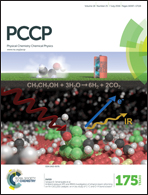Voltammetry of the aqueous complexation–dissociation coupled to transfer (ACDT) mechanism with charged ligands
Abstract
The study of the so-called aqueous complexation–dissociation coupled to transfer (ACDT) mechanism is extended to systems where the ligand species is not neutral and so the charge of the two transferable ions is different (z1 ≠ z2). This has a profound effect on the voltammetric response of the system, which shows a complex behaviour depending on the chemical kinetics, the difference between the lipophilicity of the two ions and the applied potential. Such response is modelled making use of the diffusive-kinetic steady state (dkss) approach, obtaining analytical expressions for the current–potential–time curves in normal pulse, derivative and differential multipulse voltammetries. In addition, manageable expressions for the concentration profiles, interfacial fluxes and interfacial concentrations of all the species either side of the liquid|liquid interface are derived. From them, the effect on the voltammograms of the characteristics of the chemical reaction and the lipophilicity of the ions is thoroughly studied, comparing the cases where the ions carry the same and a different charge. The last case shows some striking behaviours that can be understood from the analysis of the concentration profiles.


 Please wait while we load your content...
Please wait while we load your content...